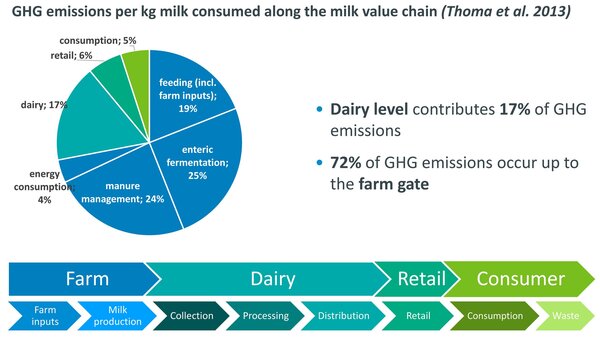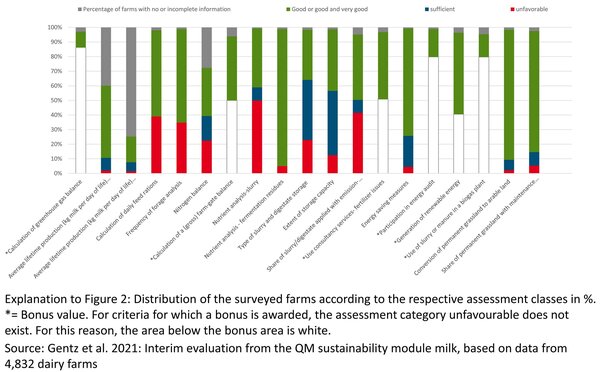Expertise
GHG emissions in the milk value chain
Katrin Agethen, Birthe Lassen | 19.01.2023
Climate protection is on everyone's lips, including in the dairy industry. Scientists from the Thünen Institute of Farm Economics point out the challenges in determining and evaluating farm-individual GHG emissions and reductions on German dairy farms.
In a survey conducted among German dairies in 2021, 60 % (n=57) stated that they have been dealing with greenhouse gas (GHG) emissions accounting for some time. However, this applies primarily to the processing level. Only a good third of the dairies surveyed also or exclusively account for GHG emissions at the dairy farm level. This will change, however. A good 70 % (n=38) of the dairies surveyed stated at the end of 2021 that they intend to address the assessment of GHG emissions on farms within the next five years. They expect pressure from food retailers and industrial customers to increase significantly in this regard and also see that reporting and improving the GHG footprint is important for the industry's image in society.
That it makes sense to include the farm-level in the dairies' climate protection activities is also shown by the fact that about three quarters of the emissions in the milk value chain are caused directly on dairy farms (Figure 1). On average, less than 20 % of the emissions are released during milk processing in the dairies, the rest of the emissions occur in roughly equal parts in the retail sector or by the consumer.
What is the footprint of milk?
Literature values show a large variance in the GHG footprint, both between countries and within specific regions and production systems. There are several reasons for this: the large heterogeneity of dairy farms themselves and the different underlying methodologies in data collection and calculation.
The extent of the heterogeneity between dairy farms is exemplified by studies conducted by the Bavarian Institute for Agriculture (Bayerische Landesanstalt für Landwirtschaft, LfL). There, almost 100 Bavarian dairy farms were analysed using the same methodology. The GHG footprint ranged between 0.8 and 1.8 kg CO₂ equivalents per kilogram of milk. The analysis also shows that no distinct correlation can be established with just one production parameter (for example milk yield). Rather, the emission intensity per kilogram of milk on the farm is influenced by several factors. These include the type of feeding and fodder production, including storage and spreading of manure, as well as herd performance parameters such as animal health, replacement rate, milk yield and other aspects.
While all calculations of the GHG footprint initially pursue the same goal, the methodologies differ in detail and thus lead to different results. Major differences result from
- the set system boundaries (which greenhouse gases from the (upstream) chain are considered?),
- the allocation factors chosen (how are the emissions distributed among the co-products, e.g. meat?),
- the chosen functional units (what does the footprint refer to, e.g. the kilogram of energy and fat corrected milk, the kilogram of milk product or the nutrient unit?).
Depending on which question is to be answered, which processes or products are to be compared, different methodological approaches are chosen. It is important to be aware of the differences and their effect on the results, and to be guided by standards (cf. German BEK standard, IDF standard). If effects within milk production are to be measured, the emissions per kilogram of milk are relevant. If, on the other hand, different human diets (e.g. plant vs. animal products) are to be compared, it makes more sense to consider the emissions per nutrient unit.
One footprint does not make a change
Knowledge about the farm level footprint does not automatically lead to a reduction in emissions. For this, knowledge about the underlying management measures and mitigation action must be available. The QM Dairy Sustainability Tool provides important information in this regard with its comprehensive sustainability monitoring. The sector tool does not calculate a specific footprint for individual farms. But it collects the most important management measures that can contribute to a reduction of the footprint at farm-level.
The evaluations of more than 5,000 dairy farms in Germany (more than a quarter of all dairy farms) are now available (Figure 2) and show where many dairy farmers are already contributing to climate protection - for example, by maintaining permanent grassland, producing renewable energy and implementing energy-saving measures on the farm. However, it also reveals where there is still a need for optimisation: especially in the area of manure application and in the use of extensive grassland. Also, many farms have neither yet sampled their basic fodder nor their slurry for constituents and rely too much on standard values from the literature. The results from the QM Dairy Sustainability Tool can be a good basis for dairies and milk producers to discuss climate protection measures together, implement reduction measures and document the successes.
Joining forces in the sector
Many dairies are currently working on the implementation of pilot projects for climate protection. These initiatives are worthwhile and important. However, the individual projects do not do adequate justice to the heterogeneity of milk production. In order to support farm managers as quickly as possible with knowledge from such lighthouse farms and to give them the chance to find a lighthouse farm that fits their circumstances, it would make sense to join forces in the sector and focus on joint knowledge transfer. Climate protection is not a task that individual farms or companies can take on and solve, but a task for the entire sector.








